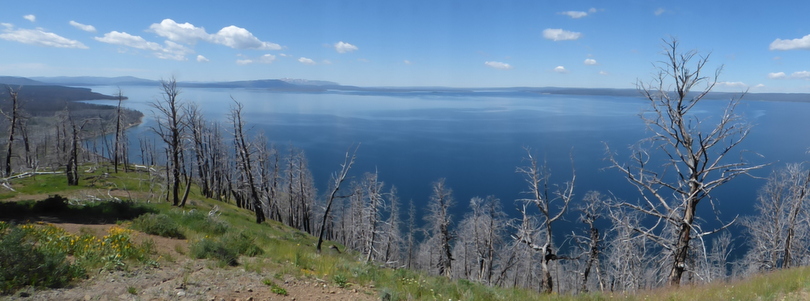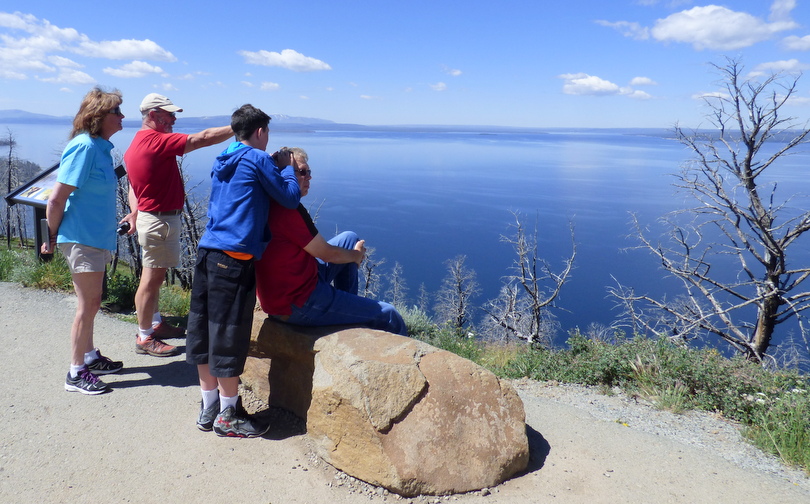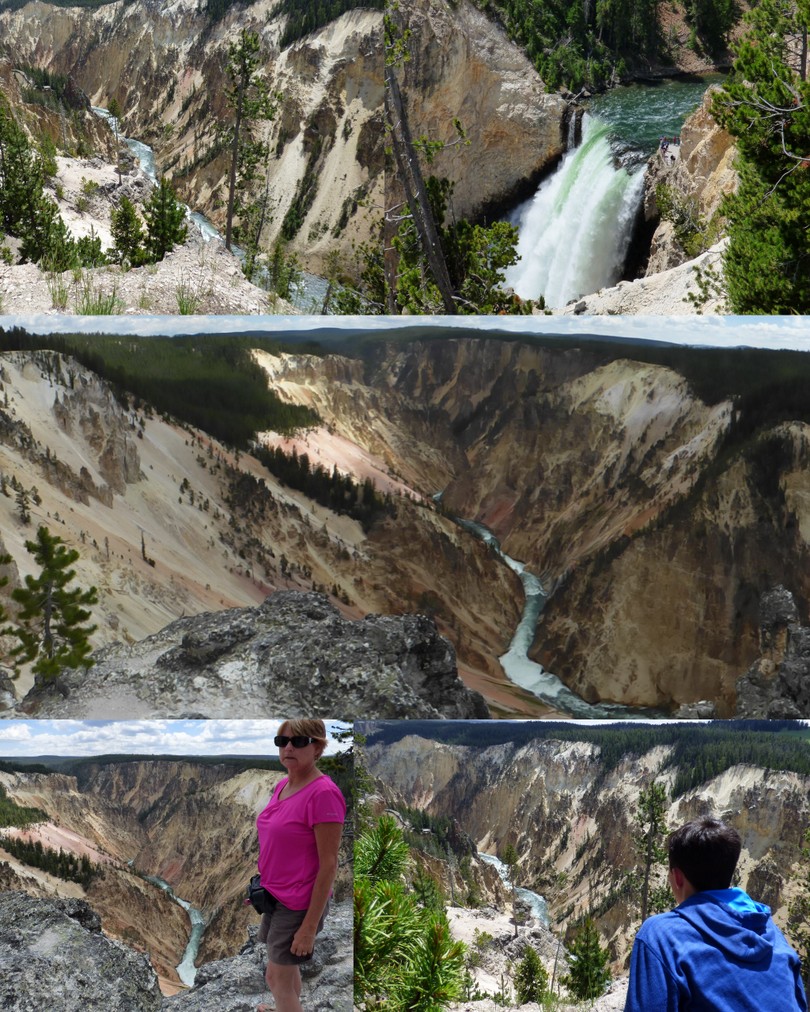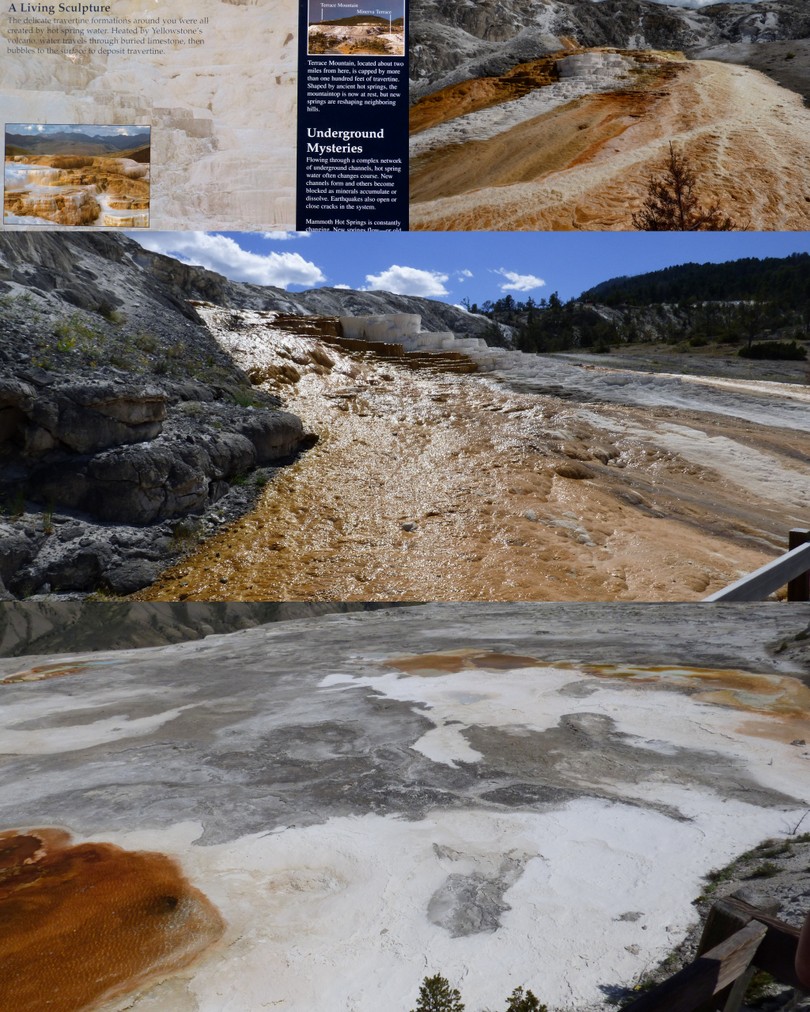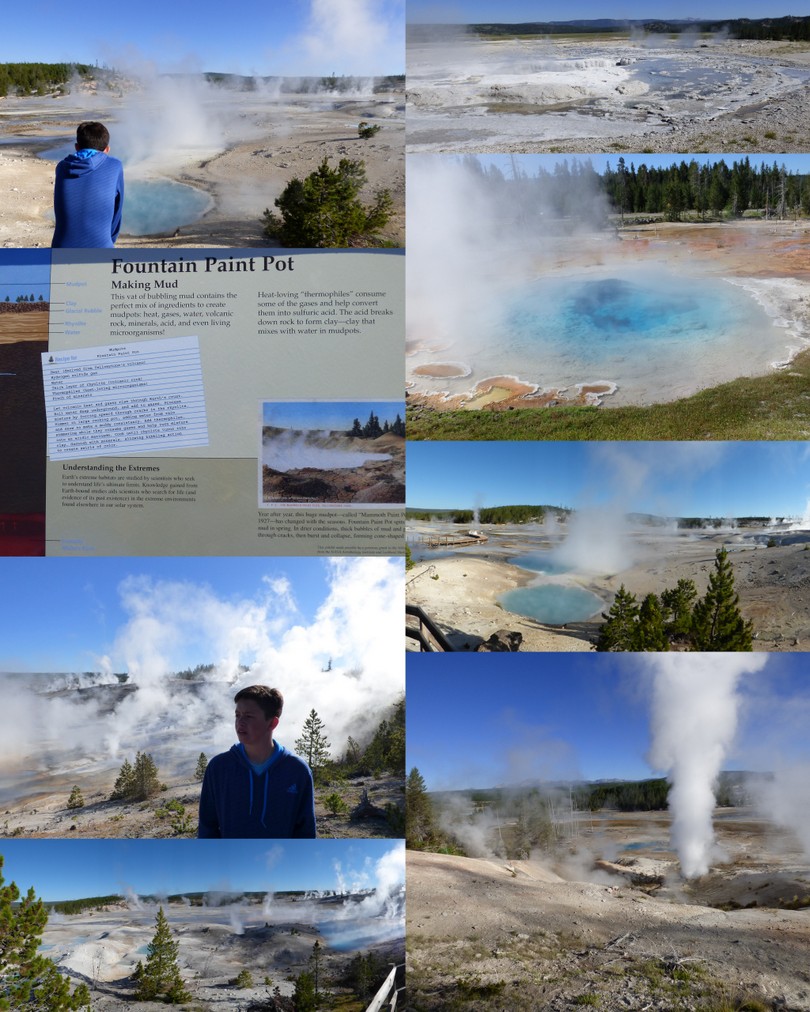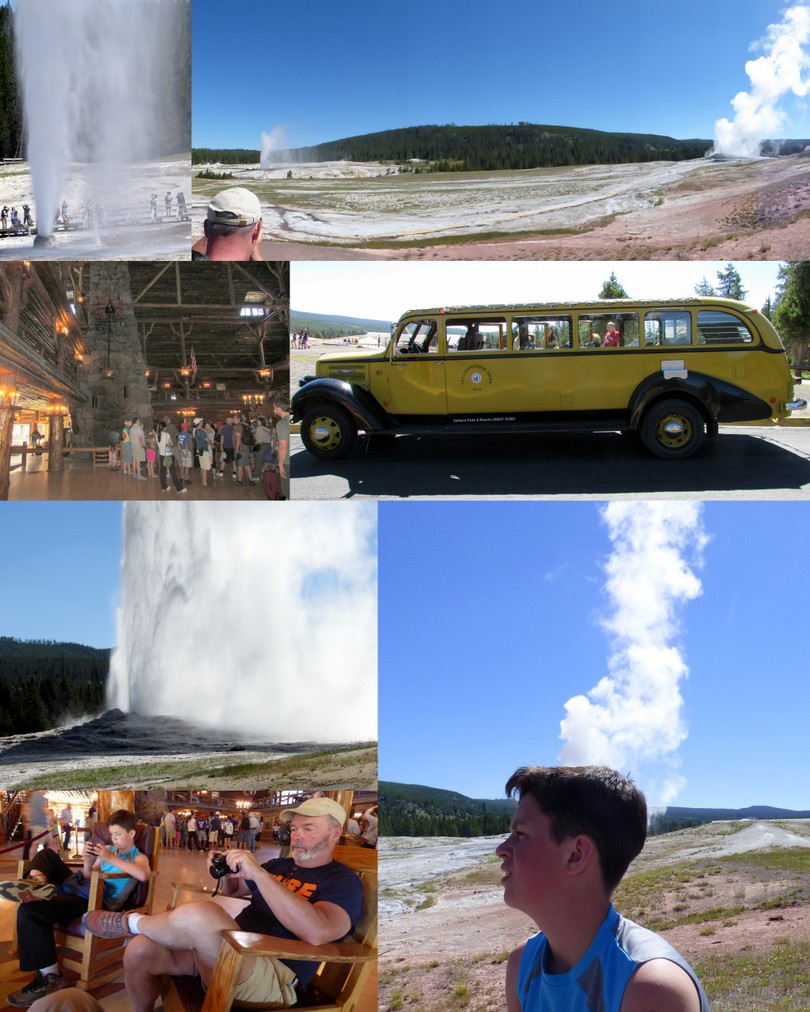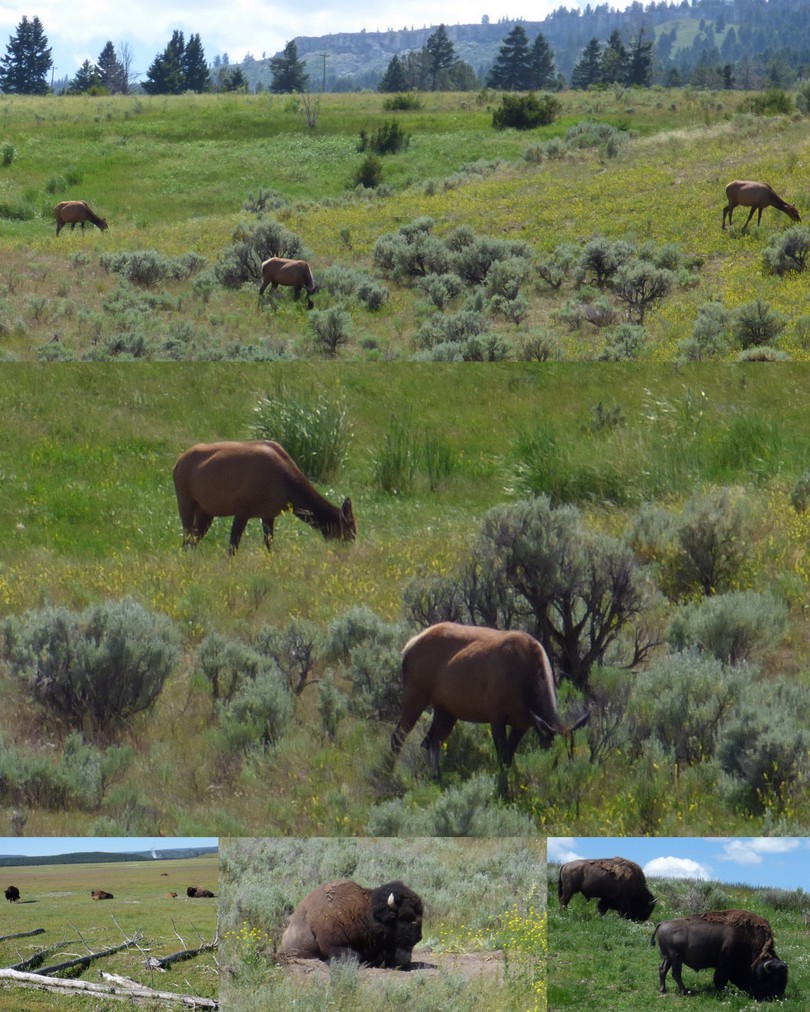Following our horse packing trip we toured Yellowstone National Park. We entered the park from the east entrance (Cody). We drove through lots of the 1988 burned / regenerating forest. Throughout the park the regrowth was uneven; in some places the regrowth was 25-30 high and very thick. Coming from the east access the regrowth was much spottier and only a few feet tall.
Yellowstone is the largest high-altitude lake in the lower 48 states, and it is breathtaking; to the south we could see the Tetons.
From Yellowstone Lake we drove to the Lower Falls of the Grand Canyon. At 308 feet high the Grand Canyon of the Yellowstone is the primary geologic feature in the Canyon District. It is roughly 20 miles long, measured from the Upper Falls to the Tower Fall area. Depth is 800 to 1,200 ft.; width is 1,500 to 4,000 ft. The canyon as we know it today is a very recent geologic feature. The present canyon is no more than 10,000 to 14,000 years old, although there has probably been a canyon in this location for a much longer period. The exact sequence of events in the formation of the canyon is not well understood. We do know that the canyon was formed by erosion rather than by glaciation. After the caldera eruption of about 600,000 years ago, the area was covered by a series of lava flows. The area was also faulted by the doming action of the caldera before the eruption. The site of the present canyon was probably the result of this faulting, which allowed erosion to proceed at an accelerated rate. The area was also covered by the glaciers that followed the volcanic activity. Glacial deposits probably filled the canyon at one time, but have since been eroded away, leaving little or no evidence of their presence.
From there we drove to Mammoth Hot Springs a surficial expression of the deep volcanic forces at work in Yellowstone. Although these springs lie outside the caldera boundary, their energy is attributed to the same system that fuels other Yellowstone thermal areas. Hot water flows from Norris to Mammoth along a fault line roughly associated with the Norris to Mammoth road. Shallow circulation along this corridor allows Norris’ super-heated water to cool somewhat before surfacing at Mammoth, generally at about 170° F. Kathryn and I had toured Yellowstone in 1977 as we drove to Seattle to attend graduate school. As we approached Mammoth Hot Springs I said to Kathryn, “I remember these as being much wetter and prettier.” Nearby on the boardwalk was a placard describing the changes to Mammoth Hot Springs over time and gave an example of the formation under wetter conditions in 1977 .
We exited the park at the northern entrance and spent the night at Gardner. We stayed at a nice long-stay complex. We ordered pizza, watched the NBA draft on TV and then most of the group took off for the Boiling River. The Boiling River is located approximately 2 miles north of Mammoth and 2.9 miles south of the park’s North gate. The Boiling River is created where a large hot spring enters the Gardner River, allowing the hot and cool waters to mix into a temperature comfortable enough to bathe in. Moving just a few inches greatly changed one’s exposure to hot or cold water.
About 50% of the tourist crowd were Oriental, German and some Australians. Due to the crowds we decided to arise earlier and visit our Day 2 destinations in the morning before the crowds assembled. We also felt we would have a better chance of seeing wildlife. Skip, Eric and Jim took 1 car and Pam, Jim and Kathryn rode in the other. We agreed to rendezvous at the Obsidian Cliffs. We visited the Norris Geyser Basin, the Upper Geyser Basin and the Fountain Paint Pot. Going out early meant there were fewer crowds to contend with.
Norris Geyser Basin is the the hottest geyser basin in Yellowstone. The basin is comprised of two distinct sections: The Back Basin is in a forest setting. It contains geysers and hot springs tucked among the trees. The Porcelain Basin is characterized by a lack of vegetation. No plants can live in the hot, acidic, water emitted from the numerous thermal features in the basin. Porcelain Basin presents a beautiful but desolate visage which is unlike any of the other geyser basins in Yellowstone.
The Obsidian cliff was made famous by Jim Bridger’s stories and tall tales. The obsidian from this cliff was used in spear and arrow heads and traded by Native American tribes distributed as far as Ohio. In reality it is visually less than impressive. We moved on, but lacking cell phone coverage our message(s) to the other car went unheard until later in the morning.
We drove on to Old Faithful geyser. Old Faithful erupts more frequently than any of the other big geysers, although it is not the largest or most regular geyser in the park. Its average interval between eruptions varies from 65 – 92 minutes. An eruption lasts 1.5 to 5 minutes, expels 3,700 – 8,400 gallons of boiling water, and reaches heights of 106 – 184 feet. Although its average interval has lengthened through the years (due to earthquakes and vandalism), Old Faithful is still as spectacular and predictable as it was a century ago.
While awaiting Old Faithful we were informed that the adjoining Beehive Geyser was preparing to erupt as well. The Beehive Geyser is larger and more powerful than Old Faithful, but also not as predictable – erupting every 9-15 hours. There is a ‘indicator geyser’ right next to the Beehive Geyser that precedes the Beehive eruption. We were able to witness both geysers erupting simultaneously. Afterwards we hung out in the lodge and waited for car 2 to arrive.
We saw wildlife through out the park; mule deer, elk, black bear and bison. Usually the wildlife were preceded by scores of vehicles in various stages of off-road parking as everyone vied for a picture. A couple of the larger bison groups had tourists walking up to dangerous distances for pictures, despite ranger’s warnings and two reported bison gorings earlier this year.
Yellowstone was nice to see, but there were always crowds to contend with. We agreed we were thankful that we visited before the big summer crowds post-4th of July.

